Saving the Birds, One Yard at a Time
Author: Jim George
It could be said that our New Hope Audubon Bird Friendly Habitat Certification program is helping to save the birds, one yard at a time. Of course, what we are doing locally is akin to a single raindrop in a small mud puddle, but similar efforts worldwide are translating into a monsoon of rain. Now it appears that what we are doing may be a very small part of a much more important endeavor. We may be helping to save life on earth as we know it!
New Hope Audubon and the North Carolina Botanical Garden recently co-sponsored a presentation by Doug Tallamy. Tallamy is the author of two very influential books including Bringing Nature Home and The Living Landscape: Designing for Beauty and Biodiversity in the Home Garden (coauthored with Rick Darke). He also has a new book coming out early in 2020 titled Nature’s Best Hope: A New Approach to Conservation that Starts in Your Yard.
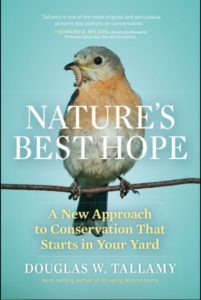 Tallamy’s new book focuses on yards.
Tallamy’s new book focuses on yards. He made the case in his presentation that saving birds and, in turn saving all of us, is about saving the insects. Insects are suffering a severe decline with many reaching extinction levels and many others threatened or present in insufficient numbers. You may think that the “insect apocalypse” that has been in the news is just exaggerated hype, but that appears to be where we are heading. I refer you to the New York Times article for more information, “The Insect Apocalypse is Here.” A United Nations report, just released on May 6, 2019, reinforces this view stating that “Nature is declining globally at rates unprecedented in human history — and the rate of species extinctions is accelerating, with grave impacts on people around the world now likely.”
Why are insects so important to life as we know it, since that’s something that doesn’t seem all that intuitive? Simply put, they are one of the main ways that plants are propagated through pollination and then, in turn, are one of the essential links in transferring the energy of the sun, which has been absorbed and transformed by plants, up through the food chain to all higher forms of life.
Tallamy also makes the point that saving our native insects should start at home in our own and our neighbor’s yards. Certainly, it is important to maintain and increase wild natural areas in parks and refuges, but these areas represent a smaller and smaller percentage of green spaces as our country gets more and more developed. Just take a drive around our local communities to get a sense of the pace of development. Our interconnected yards now represent by far the most acreage of green space and the best opportunity to have a major influence on the natural world. In addition, our yards are one of the few places over which we have near-total control without politics and other barriers to getting anything done. I say “near total” because for some of us HOA’s can be a barrier, but more on that later.
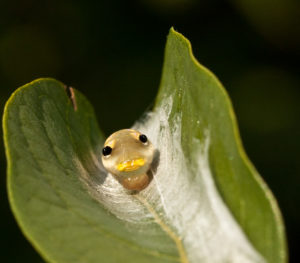 Spicebush swallowtail caterpillar on spicebush –
Spicebush swallowtail caterpillar on spicebush –by Barbara Driscoll
In his presentations and in his books, Tallamy shows that growing plants native to your location is the key because they support the most native insects. In his recent presentation, he listed 10 things we can do in our own yards to save our native insects, and in the process, help save the birds and ourselves. Most of these points will seem familiar as they echo the goals of our Bird Friendly Habitat Certification program and the themes of several previous articles written for this blog. Here is Tallamy’s list with my own comments below each point.
- Cut your lawn in half.
Lawns are not native and require water, fertilizer, herbicides, and insecticides and need frequent mowing to have that perfect look promoted by the ads from the companies selling lawn products. Lawn care harms the environment, and lawns don’t support our native insects. We’ve allowed lawns to become the definition of beauty for a property as a holdover from centuries past where only the rich could afford to have non-productive acreage in a mowed lawn. So, you should try to reduce lawn area and turn that land into something productive for wildlife. Reducing lawn area is also one of the main goals of our certification program. - Remove invasive species from your property.
Invasive plant species crowd out the native plant species that support our native insects and for the most part, support very few insects themselves. Many invasive plants are escapees from yards where we’ve planted them specifically because of their insect resistance. Several of our blog articles address invasive plants and their removal and develop this subject in much more detail, so I’ll refer the reader to these articles including: “The Alien Plant Invasion” and “Invasive Plants are NOT for the Birds.” - Use keystone plants.
Some native plants support many more insects than others. Focusing just on those that host caterpillars, the most nutritious food for baby birds, Tallamy has identified those plants that host the most moth and butterfly caterpillars and refers to these as “keystone” plants. You can find “keystone” plant groups (genera) that host the most caterpillars on the National Wildlife Federation’s Native Plant Finder and then find the species in a particular genus in our lists of recommended native plants for the Piedmont of North Carolina. For example, when I put in my zip code on the NWF website, I found that oaks (Quercus genus) host 488 caterpillars, the most of any trees, and goldenrods (Solidago genus) host 102 species, the most of any flowering perennial. Then when I looked up the Quercus genus on the New Hope Audubon recommended plant lists, I found several recommended oak species including white oak, willow oak, red oak, and more. Looking up the Solidago genus, I found rough goldenrod and wreath goldenrod. You can proceed in this way to identify keystone plants for our area, and then try to include some of these species in your landscape to have the maximum impact. - Build a landscape layered with plants.
An important part of landscape design with native plants is to have all the layers present because each in turn supports its own population of specialist insects and pollinators. Birds also specialize in what layers of the landscape they nest and feed. It starts with the canopy trees, then down to the understory trees, the shrubs, the perennial flowers, the grasses, and the vines. This is so important that having all layers present in your yard is required to be certified in our Bird Friendly Habitat Certification program. - Preserve your leaf litter.
Many insects are dependent on leaf litter for at least part of their life cycle. Whenever possible, let the leaves stay where they fall. It’s especially important not to have grass under trees since there are pupa in the leaves that fall from the tree that need to develop in the leaf litter or soil under the tree as they overwinter. This topic is explored in detail in two of our website blog articles: “Leave the Leaves” and “Littering with Leaves.” - Plant for specialist pollinators.
The caterpillars of butterflies and moths have developed methods to overcome the defenses that plants have evolved to keep from being eaten, but many can only can use a narrow range of plant species to feed. Monarch butterflies are a well-know example since they only lay their eggs on milkweeds. For more information about pollinator gardens and what plants support what pollinators, check out the blog article, “Creating a Pollinator Friendly Yard” and the NC Botanical Garden’s brochure, “Creating Your Pollinator Garden.” - Plant natives that bloom sequentially from March to October.
Bees and other pollinators depend on a food source throughout the growing season so you will need to plant a variety of flowering plants that bloom at different times of the year. My blog article titled “To Every Plant There is a Season” addresses this in detail. - Oppose mindless mosquito spraying.
Mosquito spraying uses broad spectrum insecticides that can kill or weaken anything flying at the time of application. The best way to deal with mosquitoes is to eliminate their breeding sources in yours and neighbors’ yards. The issue of spraying for mosquitoes and alternatives to spraying are explored in detail in our blog article, “The Invasion of the Asian Tigers” - Minimize insecticide use.
- In general, you should try to minimize or eliminate insecticide use in your yard. It’s a requirement of our certification program that you do so. Native plants have evolved to coexist with the native insects and will not be damaged by their feeding. Even though oak trees support 488 species of native caterpillars, most of us will not see any sign of their feeding on the oak leaves.
- Along with avoiding use of insecticides yourself, you should also try to avoid buying plants treated with neonicotinoid insecticides or “neonics” for short. These systemic insecticides are taken up through the roots of the plants after a soil drench and remain in the tissue and pollen of treated plants up to several years. They have been shown to harm the insects browsing on their leaves and the bees and other pollinators exposed to the pollen. Neonics have been totally banned in Europe but are still widely used in the nursery industry in the U.S. to treat plants while growing and before shipping the plants to the garden centers. We are working with a number of local garden centers to stop selling plants treated with neonics or at least have them identify any treated plants to the customer. When shopping for plants, you will need to ask if the plant has been treated with neonics before buying. Ideally, the plant should have been treated with only topical insecticides and not have been treated with any systemic pesticide that can be absorbed into the plant tissue. For now though, we are focusing on neonics since the case is clear for the threat they pose. You can find a list of recommended garden centers on our website, but even at these places you will need to ask about neonics.
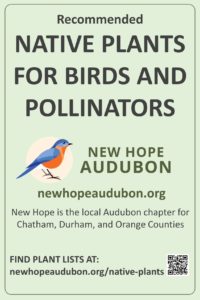 Look for our sign at garden centers.
Look for our sign at garden centers. - Join your HOA and change from within.
- If your house is in an area that is controlled by a Homeowners Association (HOA), their rules can be a significant barrier to having complete control over what you plant in your yard. Many HOA boards of directors have bought into the concept of yards needing to have a significant portion of frequently-mown lawn to meet their standards of beauty. You need to try to get on the board of the HOA and convince other board members that having non-native lawn grass is a standard fostered upon us by the lawn care industry and that native plantings are critical for the environment and can have greater beauty. Of course, a yard filled with native plants still needs be well maintained since a native plant garden overrun with weeds can be very unsightly.
- On the flip side, HOA’s can be very helpful in creating lists of what can be planted and what should not. They should ban the planting of invasives and strongly favor the planting of native species. Again, your involvement will be critical.
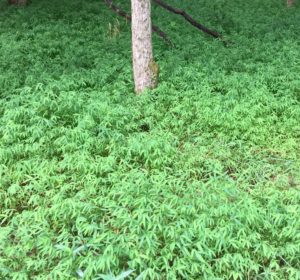 Invasive stiltgrass taking over the understory
Invasive stiltgrass taking over the understory 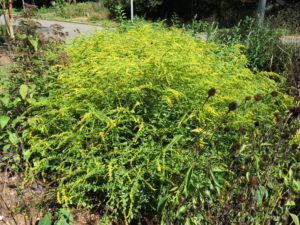 Goldenrod brightens the fall garden.
Goldenrod brightens the fall garden. 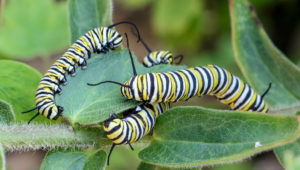 Monarch caterpillars on milkweed – by Barbara Driscoll
Monarch caterpillars on milkweed – by Barbara Driscoll 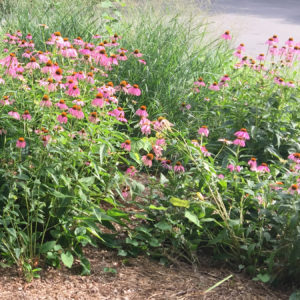 Purple coneflowers have long-lasting summer blooms.
Purple coneflowers have long-lasting summer blooms. As you work through improving your habitat for birds and insects, keep in mind that New Hope Audubon can help. If you live in Orange, Durham, or Chatham counties, you can sign up for a yard visit from our Bird Friendly Habitat Certification team. A plant expert and a recorder will come to your property and help you identify all the native plants and invasive plants and make detailed written recommendations on what they found and what you can do to improve your property. Even if you’re just getting started, have us come and advise you. You pay a onetime fee, and we will keep coming back until you qualify for certification and get your sign and certificate. Just sign up using the form on this web page. New Hope Audubon also can help by giving presentations at garden clubs and even at HOA meetings. Just contact us through the contact form on our website.
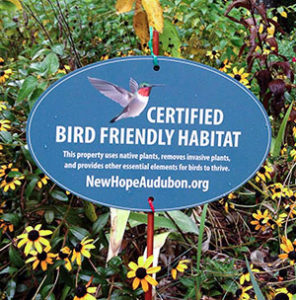 Certification sign.
Certification sign.
Converting your yard to a native plant habitat and ridding it of invasive species is a continuing journey and won’t happen overnight. I documented my own journey in the blog article “Going Native,” and two years later I’m still working on it. Please join us on this journey to save not only the birds but to save ourselves too, one yard at a time.
“It’s simple: By gardening with native plants, no matter where you live or how small or large your space is, you can help sustain wildlife.” – Doug Tallamy
“Look closely at nature. Every species is a masterpiece, exquisitely adapted to the particular environment in which it has survived. Who are we to destroy or even diminish biodiversity?” – E. O. Wilson
« Back to All Press